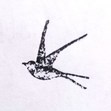Hûw Steer's Blog, page 14
August 20, 2023
What Am I Doing: August 2023 Edition
Time for another progress update. My summer thus far has been busy and full of children, as I’ve been doing workshops most days for our summer scheme – largely LEGO, but next week I get to do a creative writing session, which will be… interesting.
To business. First off: through guile, subterfuge and someone kindly giving me an invite code, I’ve made it onto BlueSky (which is basically Twitter but without… everything that’s been happening on Twitter lately). If you’re also on there, maybe give me a follow – I need to rebuild some sort of network and I’d love to hear from you anyway.
Jumping on BlueSky is part of my slow and painful attempt to actually market myself better and shift some books. I’m well aware that I’m rubbish at doing my own marketing, so hopefully more posting across many social mediums, and maybe a sale or two (stay tuned) will help get things off the ground a little. I know there are also ads and things like that – I’ll have to look at the budget. Maybe a giveaway or two, too, once I investigate postage. I have a lot of physical books under my bed waiting for someone to read them…
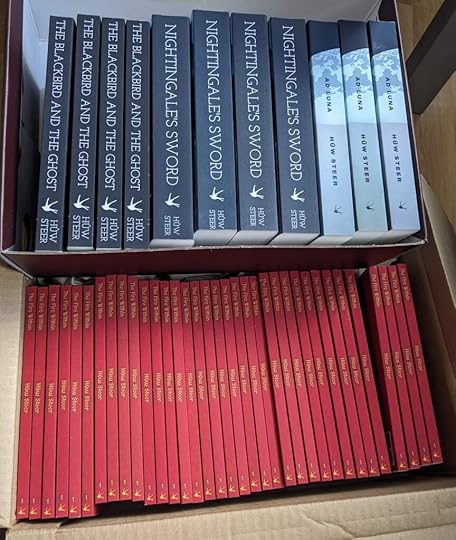 They’re not going to read themselves.
They’re not going to read themselves.I have also done a few more agent submissions, just to pass the time. I still haven’t heard back from any of those I’ve already submitted to before, of course, but it’s still progress.
So how’s Boiling Seas 3 going? Well, as I said I was going to do in my last update post, I went back and started my first pass of consistency/streamlining edits. Overall I’d like to get the final book to 90,000 words or below, just so it’s not too much of a brick, though I’ll go up to about 100k if I need to. Nightingale’s Sword was 98,000, so as long as I end up around there that’ll be fine. I’ve split the narrative into 3 parts, as is tradition – so about 25-30,000 words per part is roughly on track, right?
Part 1 is written and has been streamlined, currently clocking in at about 26,000 words – fine and dandy. Part 3 is the bit I’m currently working on, as I draw towards the exciting conclusion (to the whole trilogy, which is still a very strange feeling). I’m currently at about 20,000 words there, which is within the theoretical limit, but has a lot more left to go, so I think the first draft will end up pretty chunky – which is ok, because it’ll need lots of streamlining and trimming anyway to get things all on track.
And then there’s part 2, which I have begun editing, and is, if I open the ‘Part 2’ document, currently at 25,000 words, which is fine. It’s fine. Don’t look in those two documents labelled ‘Big Scene To Trim’ and ‘Other Big Scene To Trim’. They’re definitely not the infamous Chapter 37. Definitely not another 15,000 words in there. Nope. Nothing to see here.
So in summary, the novel progresses towards being finished, after which I do a full edit pass myself, hand it off to my long-suffering proofreaders for their notes, make those tweaks, and get on with the cover and title in the meantime. Which is obviously a lot to do, but it can be done. I think I’m still on track for this year – just might be closer to Christmas than I’d hoped.
In terms of other projects, I am still awaiting the go-ahead to talk about all the exciting short stuff that will hopefully be coming out in the next few months – but you’ll know about that as soon as I do because I’ll be shouting it from the rooftops.
Aside from that… yeah, I think that covers it. Next week we’re taking a busload of children to the zoo, so if I survive that, you’ll hear from me again on Sunday.
August 13, 2023
Christopher Marlowe – Man of Action
I love a good spy story, and history’s full of them – especially the Elizabethan period.
You’ve got Sir Francis Walsingham, who ran a huge network of spies for Queen and country – he had agents across Europe, moles in embassies, staff cracking ciphers in diplomatic letters, a small army of forgers. This was serious intelligence work, and it was needed, because there were dozens of plots against Elizabeth. Usually these were to get rid of Liz and install Mary, Queen of Scots as Queen of The Rest Of Britain As Well, with the help of an army of French/Spanish/Dutch sympathisers, depending on who happened to be behind each particular plot. Seriously, there were loads of very similar schemes. I’ve always liked the Throckmorton Plot, with all the intrigue of the Spanish ambassador, Don Bernadino de Mendoza (who also has a great name) organising a coup from within the palace itself. (One day I’ll get round to writing an SF version of that plot, it’s crying out for it…)
Of course, Walsingham’s M needed some James Bonds. Much has been made of John Dee, who in addition to being Elizabeth’s resident Clever Bloke at court, is speculated to have done a bit of spying as well. The idea that he was the ‘original 007’ because of some dodgy handwriting in a few letters is a bit much, but he was clever, and well-travelled, and probably would have brought back useful information even if he wasn’t leaping heroically off rooftops and punching bad guys.
But then there’s Christopher Marlowe. Playwright, agitator, poet, spy. A lot of his life is a mystery: many scholars have spent many years arguing over just how many of the sensational stories about Kit’s life have any basis in fact. But a lot of them converge on the idea that he was a Bond-like spy – too busy with “matters touching the benefit of his country” to finish his degree properly in 1587, hanging out with other known agents of good old Sir Francis, and spending much of the rest of his time getting arrested for flamboyantly beating people up when he wasn’t writing plays. None of it’s certain, but it seems likely.
 Christopher Marlowe (maybe)
Christopher Marlowe (maybe)But what if I told you that Marlowe really was a secret agent? What if I told you he was recruited at Cambridge in 1586, to be the lead operative of a new secret British government agency? What if Marlowe, unlike Dee, really did have a cool codename? And what if that codename was…
Action Man.
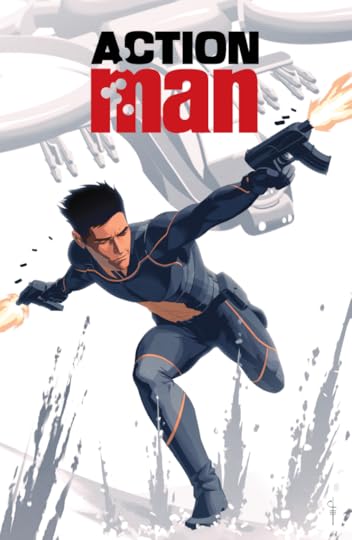 ‘England, Half-English’, Action Man #2 (IDW, 2016)
‘England, Half-English’, Action Man #2 (IDW, 2016)That’s right: this has been a ‘Comics Are Stupid’ post all along. Because in the background of IDW’s short-lived Action Man comic, the official timeline has the Action Man programme established in 1586, with Kit Marlowe as the original plastic toy hero.
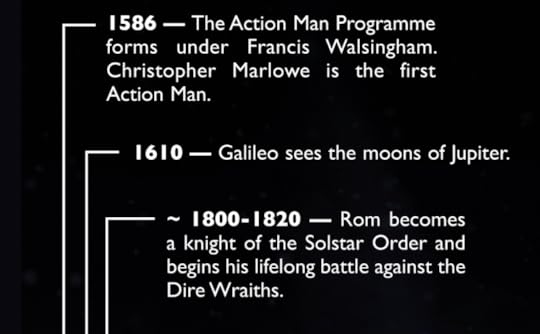 All the key events of the period. ‘Crisis Intervention’, Revolutionaries vol. 1 (IDW, 2017)
All the key events of the period. ‘Crisis Intervention’, Revolutionaries vol. 1 (IDW, 2017)(As there are no confirmed paintings of Marlowe, we cannot be sure whether or not he had Flocked Hair , Eagle Eyes
, Eagle Eyes or Gripping Hands
or Gripping Hands .)
.)
For those unfamiliar with this stalwart of every British child’s toybox, Action Man started life as the British version of G.I. Joe: big soldiery action figures doing adventures. By the time I was a kid, Action Man had moved away from the military stylings of his American cousin and become basically a more child-friendly James Bond, driving around in ridiculous vehicles, throwing gadgets, and fighting against the evil Doctor X and his plans for world domination. (There were actually several official James Bond Action Man toys, too). There was even a (rubbish) direct-to-video TV series. Many a sandcastle’s battlements were staffed by a small army of Action Men in my youth, though it was the one with the working parachute who saw the most action, because throwing toys out of windows and not having them break is always great fun.
 This guy was awesome. Action Man ‘Air Surfer’ (2001)
This guy was awesome. Action Man ‘Air Surfer’ (2001)This version of Action Man hasn’t actually been around since 2009 – the actual toys have gone back to the classic 60s style for collectors – but in 2016, there was a last hurrah for the silly secret agent in IDW’s Hasbro-Verse period, when they decided to mash every other Hasbro property they could into their ongoing Transformers series, with surprisingly not-awful results. In the comic, young Ian Noble is forced to step into the big (rubber) shoes left by his predecessor – clearly meant to be the Action Man of my childhood – and go off and save the world from his own Doctor X. It’s a light-hearted romp of a comic, and though the solo series didn’t last long, Ian stuck around in the Hasbro-Verse, going off on further adventures with an elderly robot who turns into a car, as you do.
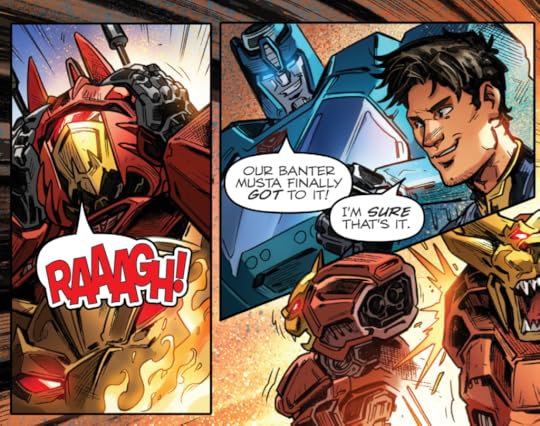 ‘The Iron Klaw’, Revolutionaries #4 (IDW, 2017)
‘The Iron Klaw’, Revolutionaries #4 (IDW, 2017)The lineage of Action Men in this version just tickled me so much. The comic does a great job of rationalising the various incarnations of Action Man toys as different Men in different periods: WW2 Action Man gives way to G.I. Joe-style Action Man (who, this being a crossover comic universe, is of course mates with G.I. Joe himself), who is succeeded by the version I grew up with, who passes the mantle to Ian Noble, the only modern Action Man unlucky enough not to have a toyline. This works well. But because Comics Are Stupid, of course IDW had to go back and make the Action Man programme 500 years old. Of course they had to made Christopher Marlowe take time out from writing Doctor Faustus to become the first Action Man.
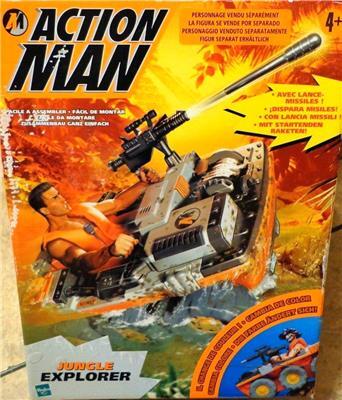 Kit Marlowe on a mission in Brazil, c.1590. Action Man ‘Jungle Explorer’ (2000)
Kit Marlowe on a mission in Brazil, c.1590. Action Man ‘Jungle Explorer’ (2000)But even though it’s a throwaway mention, it looks like the writers did their research, because Ian Noble’s becoming Action Man actually mirrors Marlowe’s own (theoretical) recruitment as a spy: both are young men, studying at college/university, pegged as skilled and intelligent by grander spymasters and brought into the fold to become agents. I love it when silly jokes are well-researched.
Action Marlowe is only an aside in a timeline but the possibilities it conjures are amazing. Did Kit Marlowe have his own Doctor X? Did he soar through the skies on a Da Vinci-style glider? Was his doublet full of secret compartments for his range of accessories? Did his arms only bend at the shoulder for some reason?
If by some chance anyone from Hasbro or IDW (or I suppose Skybound, now) is reading this, please write an Elizabethan Action Man series. (Man of Action?) Even just a one-shot. It would be one of the most stupid, greatest things ever written.
Now, if you’ll excuse me, I’m going to try and find a ruff that will fit a big action figure.
August 6, 2023
Normality and How to Use It
It’s quiet in my house right now. It has been for a couple of weeks, and it’s strange. There should be more conversation, more laughter. I’ve been talking, but only to myself. I come home in the evening and the lights are still off, there’s nobody to greet me. I was used to all this, and it took a change to make me realise just how much I was used to it.
To clarify, everything is absolutely fine: my partner’s just off in Korea for a few weeks. But it’s been strange realising all the little things that I’d been so accustomed to, living in this house with her, all the little foibles of ordinary life that no longer apply when you’re not together. I’ve managed to only go slightly mad (I already bounced ideas off the Transformers on my desk, it’s not weird, what are you talking about), but even after a couple of weeks I’m still stumbling across things I’d never realised would be different.
Now this does have a writing-related point, and it’s one I’d not really thought about before. Because I write fantasy and sci-fi, and among other reasons, fantasy and sci-fi are great genres to write in because of how weird you can get. You can fill a world with incredible concepts; bizarre creatures, impossible cities, magic and technology and wonder to boggle the mind. That’s sort of half the point of writing SF&F. But to make things feel fantastical, there needs to be a contrast. There needs to be ordinary life to for the extraordinary to work.
There doesn’t need to be much of it. In the Boiling Seas books there are only a few ‘normal’ sections: when Tal’s in town at the beginning of Blackbird, the scenes at the Lantern and a handful of others. Obviously even those scenes are only ‘normal’ for the Boiling Seas – Port Malice is still a weird and winding place, and there aren’t exactly many gigantic library towers full of magicians knocking around in our world. But they’re places where my characters are just… living. They eat, they sleep, they chat, they have a perfectly ordinary time. It gives a baseline against which the daring tomb-raids and giant airships can be measured, when I switch to the Big Fantasy Bits: a normal life from which my characters can be plucked when they go on their adventures.
As I said, ‘normal life’ in an SF&F setting doesn’t have to be that normal. I’ve written about elves living in glass towers on the Moon, about farmers in space, about canyons in the infinite desert – and that’s just me; there are plenty of wilder worlds out there to read. As long as it’s ‘normal’ for your characters, that works. But as I’ve learned over the last few weeks, you don’t need to change much for ‘normal’ to start feeling very weird very quickly. A barman on an orbital habitat can be thrown off his rhythm by an unexpected patron. A seasoned treasure-hunter can be made uneasy by just a lack of company. It doesn’t take much to establish normality in a very non-normal world, and it takes even less to undermine that normality. And from such small seeds of unease and change can great stories grow.
July 30, 2023
Doing the Research
As tempting as it often is, I don’t just dive into writing without thinking about what I’m writing about first. I don’t mean planning out the story itself – that’s a step I’m often very guilty of skipping – but all the other things that go into making a story into a proper narrative. The background, the environment, the history – all that stuff is just as important as your characters and plot. Basically, you’ve got to do your research.
Now I am fortunate enough to have a Masters in Ancient History, which means that my head is still filled with all sorts of information about ancient Greece, Rome, China and a fair bit on medieval Europe into the bargain. This means that when I’m putting together my world histories I’ve got plenty of knowledge to draw on, and quite a lot of articles and books still lying around that I can use to refresh my knowledge without too much trouble. I can assemble a fairly convincing ancient society pretty quickly by blending some different systems of government and architectural styles, inventing some sort of riff on Herodotus as an ’ancient source’, and then sprinkling on a nice selection of weird-sounding names. (And all those ancient languages are really handy for that, especially translating ancient Chinese nicknames for titles. Being called ‘The Sleeping Dragon’ is just cool.)
And for once, all the weird facts that were very unhelpful during my actual degree make for great little worldbuilding details. Medieval medicine and science is amazing for little things like this – like the strenuous scientific debates about exactly what superpowers angels had, or the biology of barnacle geese.
 They grew like this, apparently. Topographia Hibernica (c. 1188) – British Library
They grew like this, apparently. Topographia Hibernica (c. 1188) – British LibraryBut once I’m outside history and ancient (mis)conceptions of science, things get trickier. Sometimes I have to actually think about real science and geography. In The Scar, a story I wrote up a while ago (and which you might be seeing in print pretty soon…), I chose an incredibly hot and sunny environment – which meant I had to research a bunch of unfamiliar technology, plants and other environmental bits and pieces for everything to make sense. In Weft and Warp I had to research submarines to make sure my space-submarines made sense; for various other not-yet-published stories I’ve had to look up algae, and spacewalking, and the effect of gradients on railways.
It’s the same story for me right now with Boiling Seas 3 – even though there aren’t actually any boiling-hot oceans in the world, I still need to consider what impact that environment might have on the world. I’ve thought about steel-hulled ships, and heat-sinks, steam in the air and the inability to swim: all those things took me a fair while to get into the right shape before I even finished The Blackbird and the Ghost. But now I’m on weirder things. Things that live in the Boiling Seas. And again, while nothing like these creatures actually exist, there are still actual bits of science I have to consider. Pressure, heat, minerals – all these are things I knew very little about before I started. (I mean, I still don’t know that much, but I’m learning.)
Some of this research is for big, important stuff, and some of it isn’t. Sometimes I’ll spend hours reading for the sake of a throwaway line. But getting these things right can be the difference between an ok story and a great one. Even if it’s one reader, one scientist who happens to pick up something I’ve written, reads it, and thinks ‘huh, that’s actually how that would work’, or one historian who appreciates a bit of Roman trivia, it’s worth it.
Now, if you’ll excuse me, I’m going to spend a few hours reading about the history of rude graffiti.
July 22, 2023
Downtime
Writing is fun, but it’s also work. It’s not a living by itself (yet [hopefully {maybe}]), and obviously I love doing it – but it’s still work. Often I’m working my brain harder every morning than I am for the whole working day after it. So of course I need to relax in-between.
So what do I do when I’m not working? What does my downtime look like?
Well it probably won’t surprise you to know that it’s still full of storytelling, for the most part. I read, a lot – something which is obviously essential for a writer. The advantage of having an hour-long commute to work every day is that I get a couple of hours of uninterrupted reading time every day (minus a few minutes for Duolingo, Wordle and train-changing) – which is a real boon. Depending on length I usually get through a couple of books a week, all of which keeps me in the right frame of mind for writing my own stuff. (Currently it’s Chris Wraight’s Bloodlines, which is just making me want to try my hand at a bit of Space Noir myself…)
Then there’s a spot of videogames, which again is an excuse to absorb myself in more narrative – and one that I get to half-create myself most of the time through choices and actual play. I’ve always preferred story-driven games to anything else. It’s all escapism; it’s why I love fantasy and SF, after all. It’s nice to just dive into another world. Currently I’m doing that literally with Subnautica, a truly cracking underwater survival game which is one of the most immersive and frequently terrifying gaming experiences I’ve ever had. Sometimes you’re building cool bases and zipping around in submarines, sometimes you’re experiencing crippling thalassophobia as you stare into the endless void that is the deep ocean. It’s great.
 Also you can create underwater International Rescue and I’m definitely here for that.
Also you can create underwater International Rescue and I’m definitely here for that.And then there’s all the Little Weirdos of the ever-growing Warhammer et al. collection; many small armies of tiny angry people, which I can spend hours upon hours building and painting (and occasionally actually playing with, these days, which is cool) – and, again, building stories around. My favourite thing to do is converting and kitbashing: ignoring most of the instructions, using whatever bits I feel like and occasionally rebuilding things basically from scratch to create completely different-looking models in the pursuit of the right weird vibe. It’s all for the storytelling. I might have glued a machine-gun to this bloke’s shoulder because it looks cool, but thinking about why he’s got a gun for an arm, why this guy is so fanatically obsessed with chainsawing people to death – that’s the fun of it for me. Every little weirdo I build has a story. I just finished a team of alien space pirates, all of whom I named after the pirates from Treasure Island with personalities to match. I have about 45,000 words of backstory for one team of Space Detectives.
And then of course there are the other daft toys, like the Lego and the Transformers; there are the shows I watch, the comics I read. It’s all relaxing. But it’s all still storytelling, whether it’s a story I’m experiencing or one I’m building.
In a way, my writing brain is never really at rest. And that’s a good thing.
July 16, 2023
Comics Aren’t Stupid: More Than Meets The Eye
The great war is over. It’s gone on for so long that most people barely remember the time before it – many were born during it, fought it their whole lives and died without ever knowing peace. But it’s done, now. The long process of reconciliation and cleanup can begin.
But some of those weary veterans don’t want to spend the rest of their lives playing politics. The war has already consumed them for long enough – they want to be free of it, properly free of it. They’ve “earned the right to see the universe without a gun in [their] hand.”
So off they go. They get a spaceship, they band together, and they set out into the unknown. They’re not friends. Some of them fought against each other for years. Their captain is impetuous and hot-headed, their first officer as by-the-book as it’s possible to be (in fact, he wrote the book). Among their crew are wandering samurai, psychopaths looking for a fresh start, amnesiacs, manipulators, and at least two full-on war criminals. The ship’s psychiatrist has his work cut out from before takeoff. They are as ill-suited a bunch of misfits to a grand quest across the stars as it’s possible to be.
But they go. And the stories that unfold are some of the best I’ve ever read. From vast battles to intensely personal conflicts, doomed romances, ethical conundrums that would make philosophers weep, wicked humour, this world has it all. And ultimately it’s an incredibly heart-warming story. This band of wandering idiots go from being at each other’s throats to a proper crew, bonded by adversity and bloody-minded perseverance into incredibly strong friendships. It’s a story about acceptance, about hope, about love.
It’s also about giant robots that turn into cars.
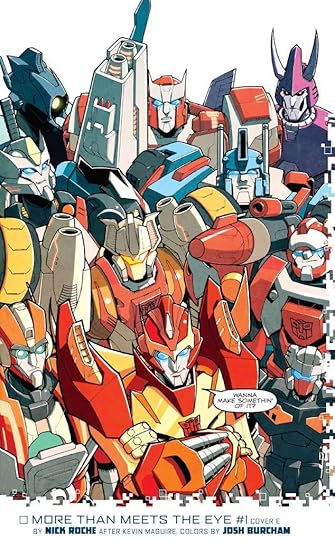 ‘Liars, A to D Part 1: How to Say Goodbye and Mean It‘, More Than Meets The Eye #1 (2012)
‘Liars, A to D Part 1: How to Say Goodbye and Mean It‘, More Than Meets The Eye #1 (2012)Yep, I’m talking about Transformers. Specifically, the IDW Transformers comics; more specifically the 2005-2018 continuity; and even more specifically the adventures of Hot Rod, Ultra Magnus and many more in 2012’s More Than Meets The Eye and 2016’s Lost Light. The Autobot-Decepticon war is over, and this merry band of morons set off into the stars to find the mythical Knights of Cybertron for… well, ‘reasons’, to be honest. Mostly they just want to be done with millions of years of war.
Because IDW really dug into the length and scope of the Transformers war in a way that no other version of the story ever has. It’s not just ‘good guys fight bad guys.’ This war has raged longer than humanity has existed. These war veterans have been getting many flavours of trauma embedded in their robot brains for millennia. There are Made-To-Order soldiers, thrown out of planes into battle seconds after they’re born. There are horrifying chemical weapons, there are torture camps, there are medical atrocities, there are terrifying prison systems – and a lot of that is from the Autobots, who are meant to be the ‘good guys’.
There are sentient landmines, requiring ‘bomb negotiators’ to calm them down so they don’t go off. This war is horrible.
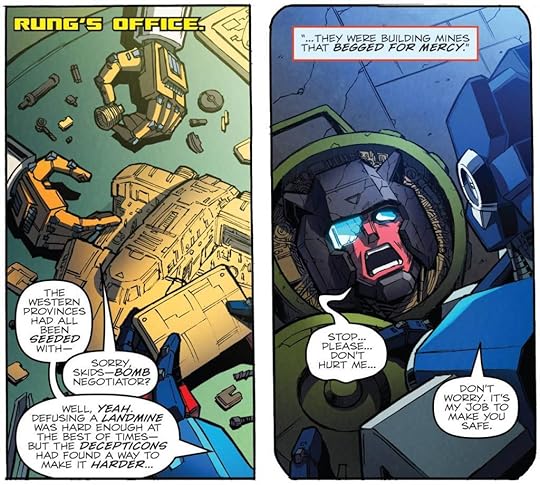 ‘Speak, Memory, part 1’, More Than Meets The Eye #48 (2015)
‘Speak, Memory, part 1’, More Than Meets The Eye #48 (2015)All of the crew of the Lost Light have suffered from this war. Whirl had his face and hands removed as punishment for speaking out against the pre-war government; once a watchmaker, he then became a psychopathic and phenomenally gifted commando. He also turns into a helicopter. Chromedome (a car) is a neurosurgeon haunted by the experiments he ran during the war, altering memories and entire personalities for the ‘greater good’. His boyfriend is Rewind (a memory stick), an archivist who watches illegal footage of dying people to try and find out what happened to his missing ex.
(And the romantic arcs in this series as a whole are very sweet, with some very unlikely pairings, i.e. a geriatric, reformed mass murderer and a hopelessly naïve tiny car.)
But there’s also Swerve, a wannabe bartender obsessed with Earth sitcoms. There’s Brainstorm, the cheery mad scientist; there’s the constant fun of Ultra Magnus, Duly Appointed Enforcer of the Tyrest Accord and resident lawman, butting heads with the pathologically lassez-faire Hot Rod; there’s Ratchet, the grumpy doctor, Nautica, the awkward quantum mechanic, and so many more. There is as much humour as there is trauma, as these broken people begin to make sense of a world where they don’t have to fight any more.
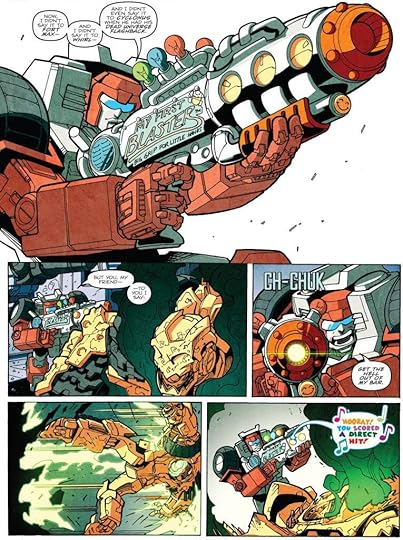 Swerve at work, with one of Brainstorm’s toys. ‘Remain In Light, 2/5: House of Ambus’, More Than Meets The Eye #18 (2013)
Swerve at work, with one of Brainstorm’s toys. ‘Remain In Light, 2/5: House of Ambus’, More Than Meets The Eye #18 (2013)I’ve just finished rereading the entire series for the third (or maybe fourth) time, and it only gets better every run-through. I’ll talk in more detail about specific bits of the run in future posts, because there are some hilarious and heartbreaking stories in there. This comic deserved every one of the (many) awards it won.
But there’s just something so wonderful about such an inherently silly subject matter – robots that turn into cars and planes and dinosaurs – being married to such a serious background, and having that background properly realised. I can sit at my desk idly playing with my toys, thinking about how cool this robot stereo is, while simultaneously remembering the horrible murder that defined his backstory.
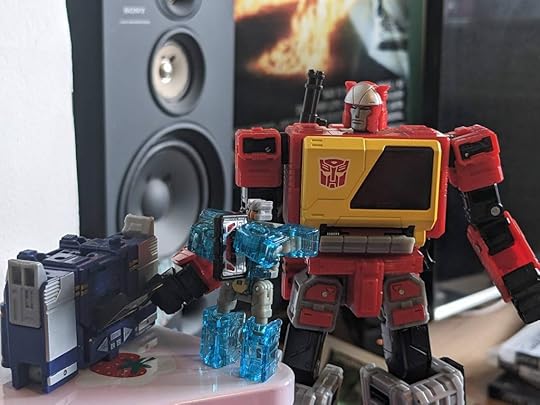 A tape player watches a cassette tape load a cassette tape into a tape player. All of them are sentient.
A tape player watches a cassette tape load a cassette tape into a tape player. All of them are sentient.IDW’s Transformers comics are very silly. They’re very serious. And they’re so, so much fun to read.
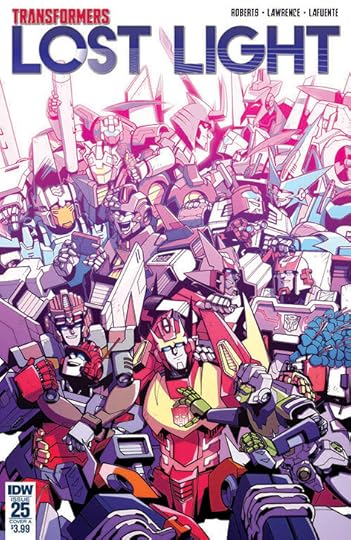 I love these guys. ‘How to Say Goodbye and Mean It, Part 2’, Lost Light #25 (2018)
I love these guys. ‘How to Say Goodbye and Mean It, Part 2’, Lost Light #25 (2018)
July 9, 2023
Lovely Weather We’re Having
Weather is weird.
And I don’t just mean the actual weather we’re currently having, which has been switching from blazing sunshine to hammering rain in a heartbeat. Though that does begin to illustrate my point, which is that for all that talking about the weather seems boring, it’s still often necessary in fiction to bring things to life – and it can be interesting too.
I’m not talking about the classic ‘sad scene = rain, happy scene = sunshine’ tropes, either. There can be much more to weather than that in sci-fi and fantasy.
Of course, starting things off with ‘it was a dark and stormy night’ is considered a cardinal sin in fiction writing, which I agree with: you can have the most interesting weather in the world and be the best writer in the world, but you should still save the atmospherics for a little further down the line. Don’t make it the focal point of a narrative – unless you’re Brandon Sanderson and you can get away with making a thunderstorm a) sentient and b) a rather compelling character.
Sanderson brings me neatly onto my next point, though, which is that if you’re writing fantasy and sci-fi, you can make your weather compelling by making it weird. Living storms? Sure. Actual hydrochloric acid rain (as briefly featured in Ad Luna)? Go for it. It can just be interesting flavour, or you can link it into the wider worldbuilding – because all weather is caused by something, and if it’s strange, that means your world must be too. I’ve written about scalding desert worlds where there’s never been rain – the lack of any weather beyond searing sunshine is an important part of establishing that background. The Boiling Seas have particularly violent storms because of all that steam in the air, and it makes things very muggy most of the time too – in this case the odd weather is a symptom of a wider worldbuilding element. But as my characters aren’t in the habit of clambering into undersea volcanoes to talk about geology (well, not yet, anyway), the weather they do experience is a handy way to illustrate those fundamental forces at work.
 And then sometimes, in Britain, it hails in the middle of June.
And then sometimes, in Britain, it hails in the middle of June. And then when you’ve got a weird world, normal weather can be weird too, and change the narrative and characters in other ways. It never rains on my aforementioned desert planet, so my characters can’t really use any rain-related idioms in their speech because they don’t know what it is. Lily Wenlock hasn’t seen snow in decades, because the Boiling Seas are too warm – if I’m ever kind enough to send that merry band somewhere with actual cold weather, they’ll have to be very confused.
Even not having any weather is important sometimes. In space, no-one can hear you complain about the drizzle, because there isn’t any. If you’re standing on some lonely asteroid there’ll just be a little dust in what passes for air, and maybe some distant, unfiltered sunlight whose radiation you have to hide from. Maybe said asteroid bloke misses planetary weather. Maybe he’s never seen it before. Either way, there’s a little storytelling opportunity there.
Strange weather heralds strange things. Don’t forget to write about them.
July 2, 2023
What Next?
I’m not that close to finishing Boiling Seas 3, but it’s getting there.
As I mentioned a few weeks ago, I’ve been doubling back and streamlining what I’ve already written before I push on into the grand finale – an approach which has already paid massive dividends even before I get to the bits that really need cutting down. I think I’ve cut about 10,000 words or so already, though I’ve been adding plenty back in to fill in the gaps and make things more coherent. The problem I always end up having, whether or not I have a proper outline for a book, is that I think of really cool ideas halfway through which I should have introduced much earlier – which means I end up half-arsedly introducing them too late in the narrative and then having to scramble to edit them in earlier on when I go back. But with this new ‘editing-halfway-through’ approach, it’s a lot easier to do that reworking of ideas. As a result, my proper villain now takes shape; characters are moving around the massive board of the Boiling Seas on a tighter schedule, and once I’ve cut down the accidentally and absolutely mammoth Chapter 37, I should be in a much better place to blaze on and write Part 3, which is something I’ve been looking forward to writing for a long time indeed.
(And then I need to do the boring things like ‘come up with a title’ and ‘make the cover’, but that’s all a future Hûw problem.)
But drawing towards the end of this trilogy has got me thinking: what am I going to do next?
I’ve been on a rough schedule of publishing a book once a year since I properly started self-publishing, and I’d like to keep that schedule up. Boiling Seas 3 will be this year’s book, all being well, but then after that… what am I going to write? I have a beefy fantasy manuscript that I started editing down a while ago (but quickly fell off) – I definitely want to put that book out at some point, but it’s a pretty dark one. Lots of desperation and despair, which I’m not sure is the vibe I’m after right now. Though it would be a good contrast to the optimism and adventure of the Boiling Seas.
I also, of course, have a kids’ book series that isn’t really a series yet. I wrote ‘Book 1’ on The Fire Within’s cover for a reason: in my head it’s at least a 5-book series, if not more, though typically while I’ve got a good idea for book 5, the intervening books 2-4 are very light on… anything. Maybe that should be the next big project – I say ‘big’, but they’re only very short books so far, which at least means they don’t take quite as long to write.
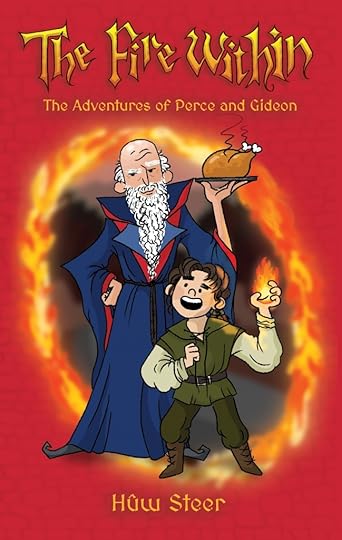 Though it does take a while for Laura Wingrove to create these excellent covers
Though it does take a while for Laura Wingrove to create these excellent coversOr maybe it’s time for something completely different. A totally new world, a totally new cast of characters. Maybe it’s short, maybe it’s long; maybe I do some long-form SF for the first time in a while; maybe I stick to fantasy and take on a different style.
I’ve got options. I just need to pick one.
Any ideas?
June 25, 2023
Getting from A to B
You can draw as big and magnificent a map as you like for a fantasy world, but at some point you have to consider one minor issue: how do people actually get around?
As I speed towards the countryside on a mighty metal serpent (well, the 9:47 from Paddington), I spare a thought for all the poor protagonists out there who have to set out on their epic quests without so much as a bus. But of course we got by for thousands of years with nothing but our legs and the legs of whatever creatures we could persuade to give us a lift, as is reflected in most fantasy. And while that works, it does require a little more thought to make your maps make sense.
Compared to someone on foot, horses are fast. Compared to a thousand-mile epic quest, horses are slow. It’s easy to forget, in this modern, hyper-connected world, that most places are actually a really long way apart. I’m off on a 3-hour train journey now – or alternatively a 2-day walk, and that’s with modern roads and infrastructure to speed me on my way. So when I’m drawing my little maps, and looking lovingly at the far more detailed maps of books like The Lord of the Rings or the Riftwar, I have to consider just how far apart these cities really are. We think nothing of a quick jaunt to a neighbouring town that might have been a week’s round trip, once.
Many books and fantasy works get this perfectly right. Half of The Lord of the Rings is literally about travelling from one place to another, and I’ve mentioned before how Feist makes sure to include some of the stops along the way as characters go from one end of Midkemia to the other. Sometimes, though, there are… shortcuts, taken. The last seasons of A Game of Thrones are notorious for teleporting characters across Westeros, and there are some awfully fast horses off-screen in The Last Kingdom.
And ultimately that’s because, unless you write it well, travelling can be boring. If there aren’t exciting plot points along the way, you’re just writing about people going from point A to point B. A quest is inherently a long journey with cool stuff happening along the way, but even Tolkien glosses over a lot of the actual walking in-between the interesting bits.
So what happens when you start adding in other means of transport? (Say, airships, or giant steel boats?) Well, first things first: obviously you can make your journeys quicker. No need to swim when you can take a ship; no need to sail when you can fly… if you can afford it. Because that’s point two: just because swifter and more convenient transport exists doesn’t mean you have to use it. Airships in The Boiling Seas are expensive and infrequent, for all that they’re far faster than lumbering metal sailing-ships – and some journeys are too short to justify any travel other than on foot. Just because you’ve got a huge map at your disposal doesn’t mean that your story has to cross a vast swathe of it. Sometimes it pays to do something a little smaller in scale.
I doubt I’ll be introducing railways to the Boiling Seas any time soon, though, for all that it’s perfectly possible with the technology I’ve already written. There are rails, there are engines, there’s a lot of metal… but as tempted as writing this sentence has made me, it’s rather difficult to build trains that cross over vast expanses of boiling seawater. Railways only really work when you’ve got a big network of them, after all, which took us thousands of years to build in the real world. Even though the ancient Greeks had physical rails in some of their mines, and also invented the steam engine, they never thought to put them together. (Which is a concept that I am constantly tempted to drop everything and start writing about…)
 Just look at all those lines. Cheffin’s Map of the English and Scotch Railways, 1850
Just look at all those lines. Cheffin’s Map of the English and Scotch Railways, 1850But that’s my point, really. Trains could exist on the Boiling Seas, but they wouldn’t be very useful because of all that water in the way – and I doubt I’d be able to resist making them constantly delayed and overcrowded. Airships are fast but I’ve made them expensive, and impractical in other ways that will be revealed in book 3, that mean they’re far from ubiquitous. Steelships are there, but they’re about as slow as it gets. For the most part, when it comes time for my protagonists to cross my map, they’re still on the reliable Shanks’ pony.
And that means that, for all that increased connectivity and ease of movement make our modern world feel that much smaller, they don’t have to do the same for your world. There are always ways to work in drawbacks and other considerations, and ways to write a long journey that make it just as interesting as what happens at either end. After all, just because you’re sitting on a train doesn’t mean you can’t admire the view.
June 18, 2023
Breaking the Block
It’s rather tricky to write when you can’t really think.
Writer’s block is an annoying and frequent inconvenience for any writer. For me, there’s always at least one big project on the go – which means that there’s always a narrative I need to get stuck into, every day without fail. And sometimes, for whatever reason, it just doesn’t flow. The right words won’t come, or none will come at all.
When you’re, say, on an eight and a bit-year streak of writing 500 words a day, this is something of a problem. I’ve got to get something down every day, block or no. So I have to try and find a way around it.
Just forcing your way through the issue doesn’t really work. Or at least it doesn’t work well; even if I can make myself get some words down they’re really not good ones. But as mentioned above, when you can’t even think your way through the next bit of story, just ‘writing anyway’ doesn’t cut it. Whether it’s just a slow day, or you’re ill, or, as in today’s case, you’re very tired after a long weekend of choir singing and carousing, getting words through the brain-fog is almost impossible.
Sometimes switching projects helps, but even then, you’re often still trying to wring creative juices out of a dry sponge/brain. And usually when I’m really stuck, it’s a universal thing: I’m not just struggling for specific ideas, I’m struggling for any ideas at all.
But I’ve got a trick. It’s served me very well in the past, for slaying the dragon that is writer’s block, for getting things flowing again. There is a way around the block. I’ve done it when I’m hungover, I’ve done it when I’m ill. And I’ll share it with you right now.
You are, in fact, already reading it.
If you find yourself unable to write, the only solution is to write about being unable to write. You can make it complex or simple, anything from a concise explanation to an overblown bit of theatre full of mad metaphors and exaggerations. Either approach has its merits – every bit of writing you do is practice, after all, and so however you decide to approach breaking your block, it’s going to be useful.
I’ve written about illness, I’ve written about rain. (I sit here now on a train back from Brighton in the pouring rain, in fact, which isn’t the most conducive environment for storytelling but it’ll do.) Whether it’s describing what’s directly ailing you or the environment around you, just get it down on paper (or chosen virtual equivalent). It might not be going in any novels any time soon, but just the act of articulating why you can’t articulate will let you break through.
If you’re a writer, you’re a storyteller. Take a moment to tell your own story, even if it’s boring.
Because now, having written 500 words about how I can’t write 500 words, I’m nicely warmed up. The block is broken, the thoughts are flowing – and I can get back to the good stuff and get writing properly.

